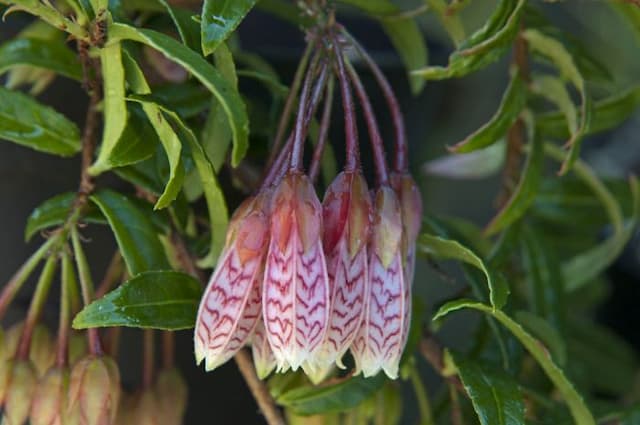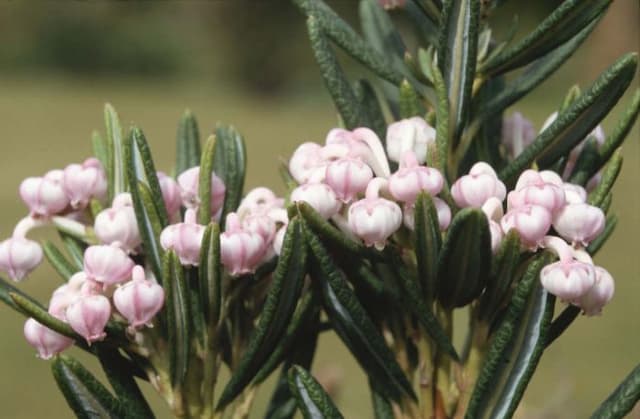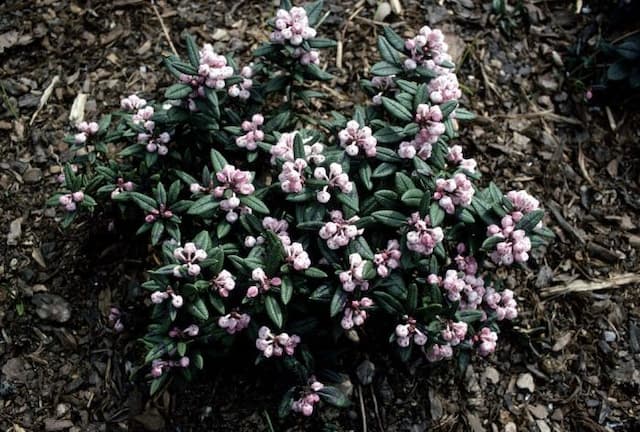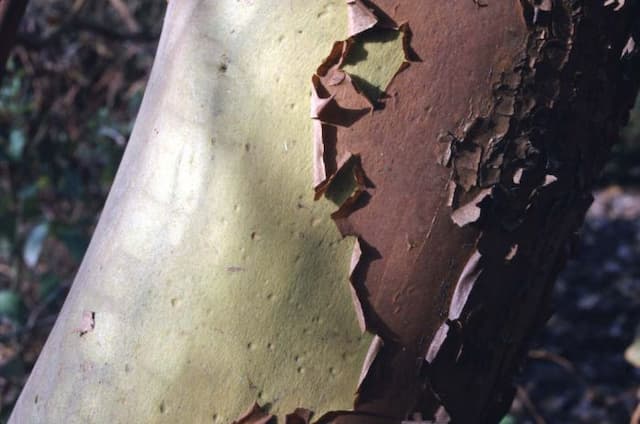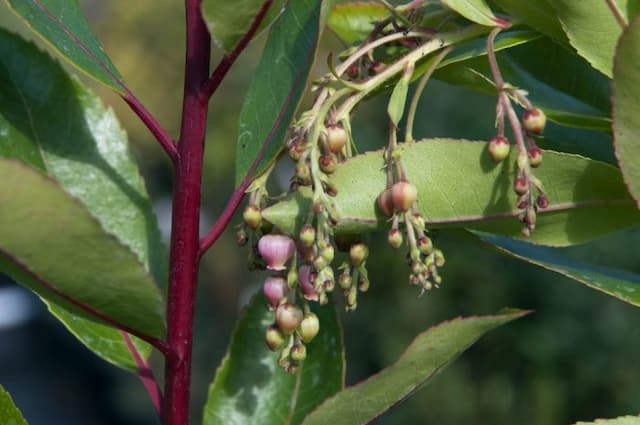Aleutian Mountainheath Phyllodoce aleutica

ABOUT
The plant known as Aleutian mountainheath has a distinctive appearance characterized by its evergreen nature and its dense ground-covering habit. The leaves are small, needle-like, and tightly packed around the stems, which creates an almost bristly or feathery look. They also have a glossy dark green color, adding to the plant's visual appeal throughout the year. Flower wise, the Aleutian mountainheath bears bell-shaped flowers that come in varying shades of pink or sometimes a purplish hue, which hang delicately from the stems. The overall form of the plant is often described as cushion-like or mat-forming, presenting a lush, textured presence in its natural habitat.
About this plant
 Names
NamesFamily
Ericaceae
Synonyms
Aleutian Mountainheath, Mountain Heather, Aleutian Heather
Common names
Bryanthus aleuticus, Phyllodoce empetriformis var. aleutica, Phyllodoce glanduliflora, Phyllodoce x intermedia, Menziesia ciliicalyx, Phyllodoce breweri, Phyllodoce aleutica var. microphylla, Phyllodoce empetriformis subsp. aleutica.
 Toxicity
ToxicityTo humans
The plant Phyllodoce aleutica, commonly known as the mountain heather, has not been documented to be toxic to humans. There is no well-known record of its ingestion leading to poisoning or adverse effects in humans. However, it's always advisable to be cautious with any wild plants and avoid ingesting them without proper identification and knowledge of their edibility.
To pets
The mountain heather (Phyllodoce aleutica) is not specifically listed as toxic to pets. However, many plants can cause gastrointestinal upset in animals if ingested. Common symptoms of plant toxicity in pets may include vomiting, diarrhea, drooling, lethargy, or difficulty breathing. If you suspect your pet has ingested this plant and is showing any concerning symptoms, it is important to contact a veterinarian promptly.
 Characteristics
CharacteristicsLife cycle
Perennials
Foliage type
Evergreen
Color of leaves
Green
Flower color
Pink
Height
1 foot (0.3 meters)
Spread
1 foot (0.3 meters)
Plant type
Shrub
Hardiness zones
4
Native area
North America
Benefits
 General Benefits
General Benefits- Ecosystem Support: Phyllodoce aleutica, commonly known as Aleutian mountain heath, provides habitat and food for various species, including insects and birds.
- Soil Stabilization: The plant helps in preventing soil erosion due to its rooting system that stabilizes the ground.
- Ornamental Value: With its vibrant flowers and evergreen foliage, the Aleutian mountain heath is valued for contributing aesthetic appeal to gardens and landscapes.
- Climate Tolerance: It is adapted to cold, alpine conditions, making it suitable for gardens in harsher climates where few other plants can survive.
- Biodiversity: By cultivating Aleutian mountain heath, gardeners can increase plant diversity in their landscapes.
- Low Maintenance: This plant typically requires minimal care once established, making it a convenient choice for gardens.
 Medical Properties
Medical PropertiesThis plant is not used for medical purposes.
 Air-purifying Qualities
Air-purifying QualitiesThis plant is not specifically known for air purifying qualities.
 Other Uses
Other Uses- Floral arrangements: The small, bell-shaped flowers of the Aleutian Mountain-heath can be used in floral arrangements for decorative purposes.
- Garden ornamental: Its attractive evergreen foliage makes Aleutian Mountain-heath a choice plant for rock gardens and alpine garden displays.
- Erosion control: Aleutian Mountain-heath can help stabilize soil in areas prone to erosion due to its mat-forming growth habit.
- Habitat restoration: It can be used in forest and alpine meadow restoration projects as part of the native plant community.
- Educational tool: This species can be used to teach about subalpine and alpine flora in educational settings such as botanical gardens and nature reserves.
- Photography subject: Aleutian Mountain-heath is a beautiful subject for nature photographers, especially when in bloom.
- Bee forage: The flowers provide nectar and pollen for bees and other pollinating insects in their natural habitat.
- Dye source: Historically, some plants in the Ericaceae family have been used to derive natural dyes; Aleutian Mountain-heath could be explored for this purpose.
- Companion planting: Aleutian Mountain-heath can be paired with other alpine plants to create a diverse ecosystem that supports various insects and improves overall plant health.
- Cultural significance: In areas where it is indigenous, the plant may hold cultural significance for local communities, potentially used in ceremonies or as a symbol in artwork.
Interesting Facts
 Feng Shui
Feng ShuiThe Phyllodoce aleutica is not used in Feng Shui practice.
 Zodiac Sign Compitability
Zodiac Sign CompitabilityThe Phyllodoce aleutica is not used in astrology practice.
 Plant Symbolism
Plant Symbolism- Endurance and Resilience: Phyllodoce aleutica, also known as mountain heather, often grows in alpine and subarctic regions, demonstrating incredible resilience and the ability to endure harsh, cold climates.
- Protection: This plant is known to survive in challenging conditions, symbolizing protection against adversity and the ability to provide shelter in difficult environments.
- Purity and Simplicity: Mountain heather is frequently associated with the untouched beauty of high-altitude landscapes, embodying the symbolic meanings of purity and a simple, unadorned existence.
 Water
WaterThe Aleutian Mountain Heather (Phyllodoce aleutica) prefers consistently moist soil without being waterlogged. It's critical to water the plant deeply, to encourage a strong root system, when the top inch of the soil feels dry to the touch. Depending on weather conditions, this might mean applying about 1 gallon of water per week during active growth in spring and summer. In the fall and winter, when the plant's growth slows down, reduce watering to half a gallon every two weeks. Overwatering can lead to root rot, so ensure good drainage and adjust the amount of water based on rainfall and temperature variations.
 Light
LightAleutian Mountain Heather thrives in full to partial sunlight. The best spot for this plant is where it will receive at least six hours of direct sunlight daily, but it can also tolerate some shade, especially in the afternoon. Avoid deep shade as it can lead to sparse foliage and fewer flowers.
 Temperature
TemperatureThe Aleutian Mountain Heather is well-suited to cooler climates and is hardy in a range of temperatures. It can withstand minimum temperatures down to about 0°F and can survive in maximum temperatures up to around 70°F. The ideal temperature for this plant is between 50°F and 60°F.
 Pruning
PruningPruning of Aleutian Mountain Heather is generally to maintain its shape and remove dead or damaged branches. Light pruning can be done in early spring before new growth begins. Prune sparingly, as heavy pruning can damage the plant. The best time for pruning is after the plant has finished blooming.
 Cleaning
CleaningAs needed
 Soil
SoilAleutian Mountain Heath prefers acidic soil with a pH between 4.5 and 6.0. The best soil mix is a combination of peat, perlite, and pine bark, providing good drainage and aeration.
 Repotting
RepottingAleutian Mountain Heath does not require frequent repotting; it should be repotted every 2-3 years or when the root system outgrows the current container.
 Humidity & Misting
Humidity & MistingAleutian Mountain Heath thrives in moderate to high humidity levels, ideally ranging from 50% to 70% for optimal growth.
 Suitable locations
Suitable locationsIndoor
Place Aleutian Mountain Heath near a bright window and ensure high humidity.
Outdoor
Plant in partial shade with moist, acidic soil for best results.
Hardiness zone
4-7 USDA
 Life cycle
Life cyclePhyllodoce aleutica, commonly known as Aleutian mountain heath, begins its life as a seed, typically dispersed by wind or animals. Upon finding a suitable location, often in alpine or subalpine regions, the seed germinates, and a seedling emerges, developing a root system and small leaves. As it matures, Aleutian mountain heath grows into a low, evergreen shrub with needle-like leaves and woody stems, forming tight clusters. The plant reaches reproductive maturity and starts to produce bell-shaped, pink to purple flowers, typically in the spring or early summer, which are pollinated by insects. Following pollination, the flowers develop into small, dry capsules containing numerous tiny seeds. This perennial shrub can live for multiple years, relying on its evergreen foliage for photosynthesis throughout the seasons, while also adapting to harsh, cold environments.
 Propogation
PropogationPropogation time
Spring to summer
Phyllodoce aleutica, more commonly known as the Aleutian mountain heath, can typically be propagated through the method of seed sowing. The most popular method of propagation for Aleutian mountain heath is by sowing seeds. Ideally, this is done after the last frost in cold frames or directly in a prepared seedbed outside. To start, the seeds should be distributed evenly over the soil and gently pressed into the surface, but not covered, as they require light to germinate. Consistency in moisture is critical, so the soil should be kept moist but not waterlogged. Germination can be slow and erratic, taking several weeks, and once the seedlings have developed their first set of true leaves, they can be carefully transplanted to their permanent locations, maintaining a spacing of about 12 inches (30 centimeters) between plants to ensure sufficient room for growth.
